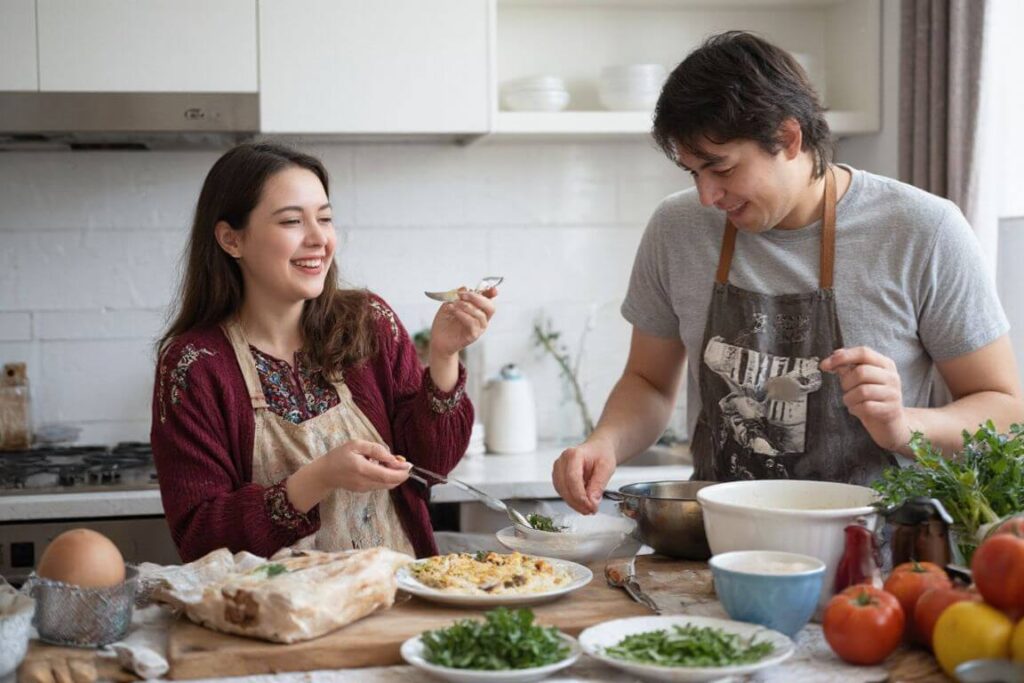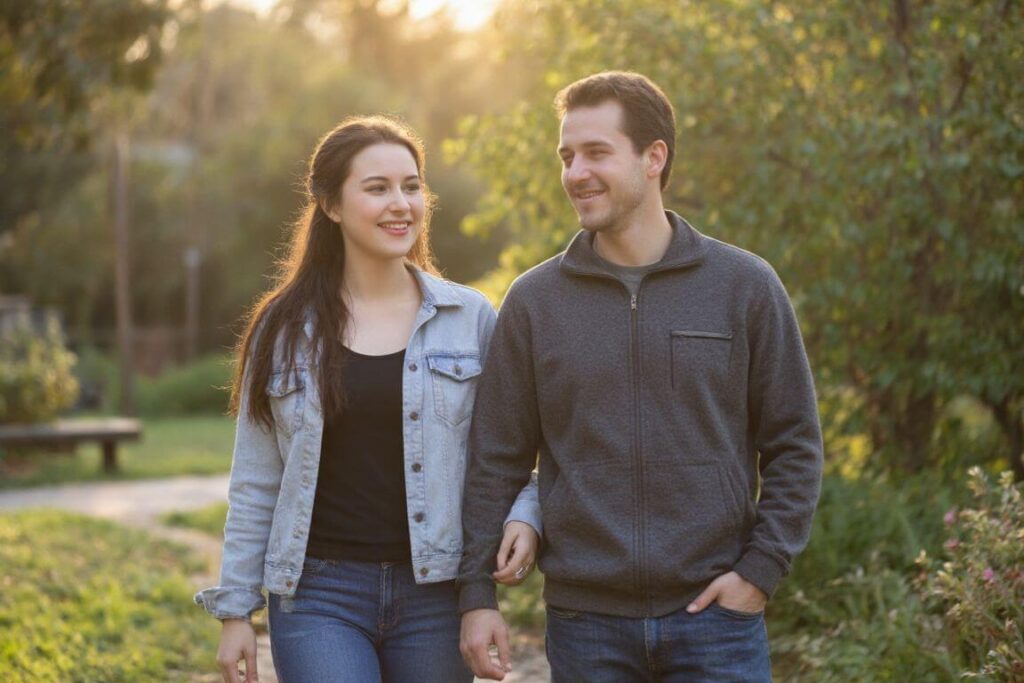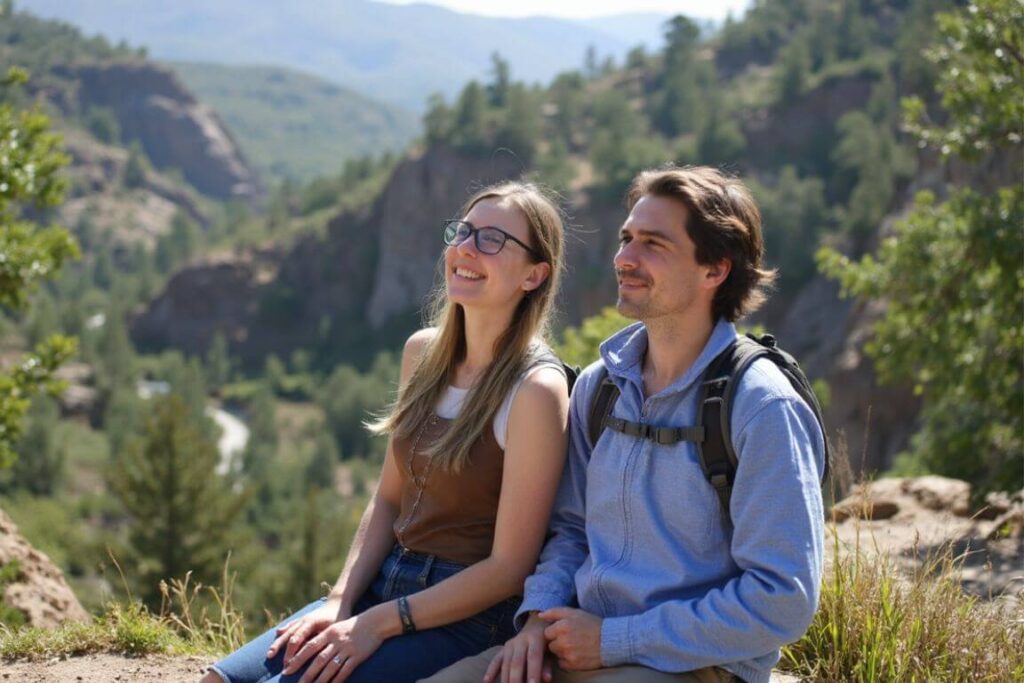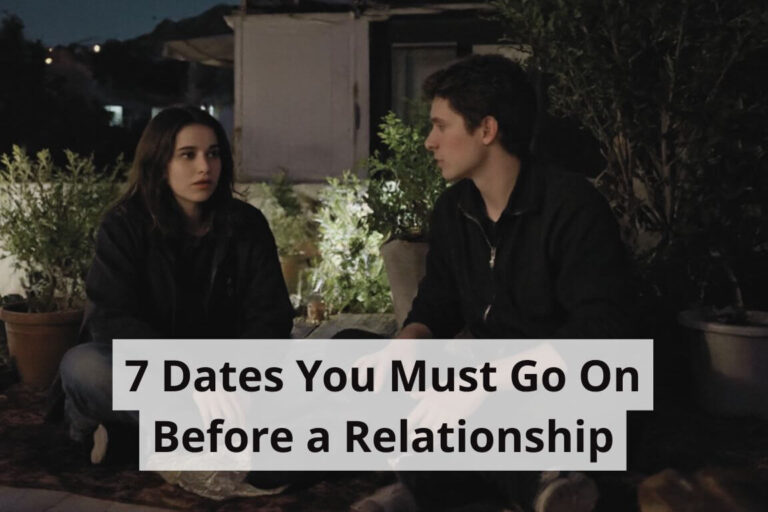Imagine walking into a café where the air feels easy and there is no rush to perform. A corner table, soft light, uncrowded mood, this becomes your sanctuary to explore a connection.
In those early moments, what you’re really discovering is not just chemistry. It’s comfort, curiosity, honesty, and emotional pacing.
In this guide, you’ll journey through 7 meaningful types of dates that help you sense whether it feels right to move forward.
Not by ticking off a checklist, but by tuning into moments that feel clear. Each date is an invitation to ask subtle questions, not to uncover red flags or demand declarations, but to feel and reflect.
Whether you feel ready or you’re still wondering about next steps, the real question is: Do you feel more “we” than just “me and them”? When these quiet signals align, the idea of us begins to feel less like a choice and more like something already unfolding.
1. The Ice‑Breaker Date
This early date feels soft and open, letting both people sense whether there is a natural ease, without rushing into anything serious. In this Date, the aim is to sense whether there’s enough natural rapport to move forward.
If both people leave feeling lighter, more curious, and quietly looking ahead, then you’ve stepped gently and well into the journey.
Where to go & What to do
Choose a cozy café with gentle music and soft lighting where conversation can flow quietly.
Alternatively, a short walk in a nearby park or by a lake with a drink in hand can set a relaxed mood. Under open skies, conversations often feel lighter and more free‑flowing.
Gentle conversation openers
Instead of standard small talk, begin with questions that invite stories:
- “What’s been the most fun thing you’ve done lately?” offers a window into what makes them light‑up.
- “What unexpected thing happened to you this week?” adds a touch of spontaneity and everyday charm.
When they share, reflect back:
- “That’s awesome, what made it stand out?”
- “How did that come about?”
Slightly deeper openers to follow
Once the tone loosens, follow with a couple more open questions:
- “What’s something you’ve wanted to try or learn recently?” invites bits of aspiration or curiosity.
- “If you could relive one moment from the past year, which would it be and why?” lightly taps memory and emotion without pressure.
The goal: create a ping‑pong conversation, not an interrogation. When they answer, share a small reflection of your own, this builds harmony.
Watching for ease & presence
Notice body language: do their shoulders drift toward you? Do they smile or laugh when you share stories? Do they maintain gentle eye contact?
These subtle cues reveal comfort more than words. If conversation feels effortless and time flies, that’s a very encouraging sign.
What to avoid early on
Skip heavy or invasive topics like past breakups, financial status, or personal history too soon. Questions such as “Why are you still single?”, “How much do you make?”, or probing about ex partners can shut down a connection before it really begins.
Signs a good Ice‑Breaker Date
- When you share something small, they respond with curiosity or detail
- They ask follow‑up questions without being prompted
- There’s a natural urge to extend the evening: “Want to walk around or grab something sweet nearby?”
- Neither one wants the date to end, the energy simply flows
Ending softly with a small invitation
As the date winds down, offer a light remark:
- “I’ve really enjoyed talking with you, this felt easy.”
- “If you’re up for it, I’d love to do something fun again soon.”
This gentle question isn’t pressure, it’s an opening. You’re subtly checking whether they also feel that ease and warmth enough to be curious about what comes next.

2. The Conversation Deep Dive Date
This date invites a deeper groove than the Ice‑Breaker, now the goal is to explore values, aspirations and emotional texture. It is a chance to listen, learn and reflect together.
Where to go & What to do
Choose a slightly more engaged environment than a coffee shop, but still low pressure: perhaps a relaxed wine bar, a light shared meal, or a quiet walk around a scenic neighborhood.
Somewhere that encourages lingering, sipping, pausing, enough time for reflection without feeling formal.
Gentle starts that open beneath the surface
Begin with curiosity-driven questions that invite honest sharing rather than rehearsal. Relationship coaches suggest questions like:
- “How do you support your friends when they’re going through a tough time?” – a gentle way to glimpse their emotional values and empathy.
- “What’s one piece of advice you wish someone had told you sooner?” – invites self-awareness and humility.
When they answer, stay present: reflect a phrase back, follow up with a soft “Why?” or “How did you come to learn that?” Keep the tone open and curious, not pressing.
Deeper, reflective questions to layer in the conversation
Once comfort builds, gently introduce questions that explore inner world and life philosophy:
- “When was the last moment you felt truly at peace?” – taps emotional landscape.
- “What belief have you changed your mind about in recent years?” – shows evolution and openness.
Offer your own reflections in response. It’s a dialogue, not an interrogation.
Storytelling instead of interrogating
True engagement comes from storytelling. When you ask about their challenges or lessons learned, share a brief personal moment too, this creates resonance.
According to therapists, asking “Is love a feeling, a choice, or both?” can gently open perspectives on emotional approach.
Focus on active listening. If your phone is out, put it away. Staying distraction‑free is proven to deepen presence and foster trust.
Body language & emotional tone
Notice subtle signals: do they open their posture when talking about something they care about? Do they relax into quiet moments? Is there warmth in how they listen to you?
These nonverbal cues often tell more than words.
Questions to avoid at this stage
Avoid clinical or judgmental phrasing: skip topics like salary, politics, detailed past relationships. Prioritize questions that feel like invitations, not cross–examinations. Gently explore rather than pry.
Signs this date feels like a meaningful deep dive
- The conversation lingers beyond superficial topics and both of you stay engaged
- You learn about a value or challenge they hold dear
- They follow up on something you shared with nuance or curiosity
- There’s a quiet ease between pauses, rather than tension or silence
Light closing to invite another layer
As things wind down, offer a thought that connects to something shared:
- “It was really insightful to hear how you think about that…”
- “I loved hearing that, I feel like we could talk more about this next time.”
This closing respects the tone and opens the door for a next step, should both feel curious enough to go deeper again.

3. The Friends & Social Setting Date
This kind of date offers a gentle window into how someone behaves in a group context, especially with your friends. It reveals social ease, style of connection, and emotional presence in a setting beyond the one‑to‑one.
Where to go & What to do
Choose a casual group setting where conversation can flow naturally: a brunch or light dinner with a few friends, a trivia night, or a relaxed outdoor gathering like a picnic.
Psychology Today highlights that group interactions ease tension and allow you to observe how someone fits into your everyday world.
rivia night or a friendly quiz event works well, structured enough to engage the group, but light enough to let people relax and show their personality.
Friendly intros and subtle observation
Introduce your date by name and share a small detail to ease first impressions. For example: “This is Alex, they’re into indie music and love cue trivia nights.”
Then ask quietly: “How are you finding the group so far? Anything you noticed or enjoyed?” This invites them to share observations without feeling spotlighted.
Watch how they engage:
- Do they join conversations willingly or hang back?
- Do they laugh and contribute naturally?
- Do they make eye contact, connect with different people, or mirror the group’s energy?
These subtle cues often show how comfortable someone would be outside of a one‑on‑one bubble.
Follow-up prompts to encourage reflection
If they remark on something positive or curious, respond with a gentle follow-up like “You seemed to hit it off with my friend Jordan over trivia, do you enjoy games like that?” Or “I noticed you smiled a lot with Olivia, that was nice to watch. Share what made it fun?”
These questions open space for more sharing and show that you’re noticing and valuing what they bring to group dynamics.
What to avoid
This isn’t the moment for probing personal topics. Avoid interrogative or intrusive questions like “Have you ever dated someone in my friend group before?” or putting them on the spot.
The aim is to observe connection rather than inspect it. Keep everything light, inviting, and grounded.
Positive signs from this type of date
- They engage with multiple people without needing you to prompt
- They show genuine curiosity toward others in the group
- You feel your friends were at ease around them
- They remain part of the energy even after you step away, and later casually check how you felt about the vibe
Graceful closing to plant a seed for next step
As the night ends, you can offer something like: “You seemed to fit in really well tonight, that was lovely to see.” Or “I noticed you sparked a few laughs with everyone, that made me smile. Would be nice to do something small again soon.”
It doesn’t demand a next date. It quietly leaves room for both of you to reflect on what felt natural.

4. The Adventure or Learning Date
This date invites both people into a shared adventure or learning experience. It might be cooking together, visiting a museum, attending a painting class or joining a trivia night.
Such moments allow you to experience cooperation, laughter, and comfort in discovery.
Where to go & What to do
Choose something new or playful: a cooking workshop, a pottery or art class, a science museum, or a trivia night at a local bar. According to relationship coaches, these so-called education dates let couples build a bond through shared growth and curiosity.
Trivia nights in particular offer structure without formality, they spark cooperation, gentle competition, and topics to talk through together.
How to frame the outing
Begin with light enthusiasm: “I thought it could be fun to try something like trivia or a one‑time pottery class. It relaxes the pressure and just lets us figure things out together.”
You are offering an invitation to explore, not an audition.
Questions to ask during the experience
As you proceed, sprinkle in curious prompts:
- “What do you enjoy most about learning something new?”
- “How do you feel when we collaborate on a trivia question or a recipe?”
These questions encourage reflection on teamwork, communication style, and shared energy.
Follow‑up reflections
After a puzzle or cooking exercise, try: “That part felt fun, when you suggested that idea it improved everything. Do you often enjoy suggesting plans like that?” Or “I noticed we laughed a lot at that question, did it feel easy being playful with me?”
This builds awareness of emotional rhythm and interaction style.
Why it works
Shared novelty tends to release dopamine and strengthens emotional connection during bonding activities like painting, cooking, or gameplay.
When partners encourage each other, even simple touches or smiles, oxytocin levels rise and comfort grows.
Meanwhile, quiz‑style cooperation strengthens communication and lighthearted trust, even in strangers at first date level.
What to avoid
This is not the moment for performance anxiety or rigid expectations. Avoid over‑planning or turning every detail into a test.
Let mistakes happen with humor or ease. The value is in learning together, not being perfect or winning.
Positive signs from an Adventure or Learning Date
- You both participate and laugh naturally, even at mishaps.
- Communication flows when things go wrong or need solving.
- You feel a sense of “we” forming through shared effort.
- There is curiosity about what else you might learn together in the future.
Gentle close and invitation for next step
As the date ends, mirror the tone of mutual discovery: “That felt really fun and easy, thanks for being a great partner through it.”
Then soft‑ask: “Would you like to try something else like this together sometime?” That kind of close checks whether the curiosity remains.

5. The Real‑Talk Challenge Date
This kind of date introduces a gentle challenge or real‑talk moment, through a playful game, tasting something unfamiliar, or a small task. It reveals how both people handle mild tension, surprise, or emotional honesty.
Where to go & What to do
Pick an activity that introduces a light test: maybe trying an unusual dish at a food stall together, playing a cooperative board game, doing a scavenger hunt, or engaging in a timed challenge like a puzzle room or quiz.
These challenge dates offer a chance to respond to small stress or surprise while still staying playful and safe. According to relationship guides, these shared tasks spark trust, communication, and authenticity in a way that routine dates cannot.
How to introduce it with care
Begin with light framing: “I thought we could try something together that feels a bit unexpected, a quirky food stall challenge, or a quick puzzle game. No pressure, just to see how we handle it together.” This sets tone for exploration without performance anxiety.
Questions to ask during or after the challenge
As you go through the activity, gently reflect:
- “That twist surprised me, how did you feel when it happened?”
- “What did you notice about how we worked together when the pressure was there?”
These prompts invite emotional awareness, partnership rhythm recognition, and shared humor.
Follow‑up reflections that create depth
After a moment of gentle tension, like losing trivia round or tasting something unfamiliar, say something like: “I appreciated how you laughed when that puzzle stumped us. Does being playful even in confusion feel easy for you?” Or “When the dish tasted odd, you stayed curious instead of shut down—that felt freeing.”
These comments highlight adaptive style and emotional safety.
Why this step matters
Challenge dates reveal how people handle small risk, uncertainty, or embarrassment without judgment. They spotlight realness and flexibility in emotional responses.
Research shows that navigating surprise or novelty together increases bonding and trust because moments of vulnerability release oxytocin, the so‑called connection hormone.
If someone can stay curious and open in a minor challenge, they often carry that skill into deeper situations.
What to avoid
Avoid anything that feels overly serious or that could trigger defensiveness. This is not the time for heavy personal questions or criticism.
Also avoid overly competitive setups that could turn awkward. The goal is light challenge with safety, not performance or intimidation.
Positive signs from this type of date
- You manage small surprises with humor rather than tension
- You solve a simple challenge together and feel rapport in how you respond
- You see vulnerability or adaptability without awkwardness
- Conversation afterward is natural, relaxed, and open
Smooth closing with a subtle invitation
When the date winds down, share a moment of appreciation: “I really enjoyed how we handled that surprise moment together.” Then softly suggest: “If you like, we could try another small challenge sometime, you and me tackling something unexpected.”
No pressure implied, just a gentle check whether curiosity remains.

6. The Everyday Comfort Date
This date is all about steady ease and gentle presence. Whether you’re sharing a coffee at a cozy café, walking through a quiet neighborhood, or cooking together at home, the aim is to see if spending ordinary time together feels calm and welcome, that kind of comfort often precedes long-term connection.
Where to go & What to do
Pick a setting that feels unrushed and open: a long coffee at your favorite café, a slow stroll in a nearby park, or a simple at-home cooking session.
Home-based cooking has been praised by relationship experts as a way to build peaceful familiarity and teamwork through shared tasks and conversation. Even just planning a weekly coffee or meal together, a casual habit, can deepen partnership in a low-pressure way.
How to ease in and begin conversation
Open with simple curiosity about the ease of the moment: “This feels nice and calm—do you enjoy this slower pace?” Or “It’s good to just walk and talk without a destination, isn’t it?”
These openers invite observation about comfort without expectation.
Questions to ask during the date
Gently explore what brings calm or ease in their life:
- “What’s something about your weekends that really helps you unwind?”
- “When did you last feel really at ease, and what helped create that moment?”
These prompts invite thoughtfulness without pressure and show interest in their rhythms and needs.
Moments to simply observe and feel
Sometimes the real question is unwritten. Notice whether conversation flows easily when silence falls. Does sipping on tea or chopping vegetables feel natural in their company?
If you can share quiet time and still feel at home, that says a lot.
Why it matters
Everyday comfort is the soil where deeper trust grows. According to experts, cooking together or sharing simple routines shows cooperation, communication and emotional stability, ingredients of lasting connection.
Building small rituals, like weekly meal planning or at-home time, can anchor a relationship in genuine comfort rather than constant novelty.
What to avoid
Avoid turning quiet moments into forced conversation. This date is about gentle ease, not interrogation. Skip big announcements or heavy topics, let this space be a soft test of mutual calm.
Positive signs from an Everyday Comfort Date
- You want to stay longer even when nothing formal is planned
- Conversations flow without strain, even in silence
- You feel naturally curious about planning another relaxed moment together
- Small gestures, like pouring tea or leaning close, feel effortless
Gentle closing with a soft future hint
As the time ends, offer a calm reflection: “Spending this slow morning with you felt lovely.” Then lightly say: “If this feels good to you too, it would be nice to do something like this again.” No urgency implied, just gentle check of shared ease.

7. The Future‑Oriented Date
This date gently introduces the idea of us together in the future. Through casual planning or imaginative talk, like a mini trip, festival visit, or shared life goals, you begin using we and us, which is often the first unmistakable sign of moving beyond two individuals toward something more anchored.
Where to go & What to do
Choose a relaxed yet inspiring setting: perhaps a scenic café with travel magazines, a quiet rooftop or riverside bench, or a stroll through a weekend market where future ideas emerge naturally.
You can even browse together for mini‑trips or festivals on your phones. This shared exploration feels hopeful without heavy commitment, just two people imagining shared possibility.
How to set the tone
Begin with playful curiosity: “I wondered whether we’d enjoy a small getaway somewhere local or join a festival next month. What springs to mind when I say that?”
This opens a doorway to shared thinking rather than individual preference.
Questions to weave in during the date
Invite imagination and shared vision with prompts like:
- “If we planned a weekend trip together, where would you want it to be and what would feel fun?”
- “How do you picture our routine if we lived nearby or traveled together for a few days?”
These questions encourage using we/us language and start aligning small intentions.
Follow‑up reflections that deepen the moment
Reflect lightly on what they share: “That idea about a little coastal road trip felt really natural to picture us doing that.” Or “Talking about that festival together, when you described it, I could almost feel us there.”
These gentle reflections reinforce shared anticipation.
Why this step matters
Dating with a future lens shows intention and readiness to move from wandering curiosity toward mutual direction. When people begin using we in their language and explore shared dreams, it strongly signals emotional alignment.
In a world where many are dating with long‑term intention from early on, these conversations can help gently reveal compatibility in values, pace, lifestyle and aspirations.
What to avoid
Don’t turn this into a formal planning session or checklist of life goals. Avoid pressure questions like “Do you want to get married?” or “How many kids do you want?”
This is not about finalized answers but early vision casting. Keep the tone open, curious, and imaginative, not directive.
Positive signs from a Future‑Oriented Date
- You both naturally begin using we when suggesting activities or routines
- The vision feels shared, not one‑sided or rehearsed
- You sense mutual curiosity rather than agreement pressure
- The conversation ends with a subtle plan or shared idea that both feel open to
Gentle closing with a soft possibility
Toward the end, you might say: “It feels exciting to imagine doing something like that together.” Then softly offer: “If that idea still feels good another time, maybe we could find a day or two to make it happen.”
It’s a light check of mutual interest with no expectation.

How Many Dates Before a Relationship?
Many of you wonder when casual dates turn into something more intentional. This section gently answers that, not by insisting on a number, but by focusing on emotional milestones, comfort, clarity, and mutual direction.
What experts and experiences show
- Dating experts often cite five to ten dates over six weeks to two months as a common timeline when people begin defining exclusivity or relationship status. Couples often feel ready around 4–5 dates when values align and connection deepens. Some relationships still take longer depending on circumstances.
- A popular guideline is chatting about exclusivity after 4–6 weeks, once a foundation of emotional trust and curiosity is built.
- Stories from people on Reddit reflect a range: some felt certain after just a few dates, others took up to ten before feeling ready. One voice noted that after roughly 7–10 dates most people intuitively knew whether they wanted something serious.
What really matters
- It is not about hitting a magic number, but noticing key emotional signals:
- Comfort in meaningful silence or simple routines
- Consistency in showing up and communication
- Clarity about shared intentions and values
- Momentum through small next-step invitations (like the Future‑Oriented Date)
Questions to help guide your timing
After a few shared dates or experiences, ask yourself:
- Do I feel more “we” than just “me and them”?
- Is there enough trust and curiosity to build something deeper?
- Can I still feel open to planning next moments together?
If the answer is yes to these, it may be time to check in about exclusivity or next steps.
Signs you might still need more time
- Uncertainty after around four dates or several weeks
- Still feeling casual rather than curious
- Conversations about the future feel vague or one-sided
In that case, continuing to weave in milestones like the Conversation Deep Dive or Everyday Comfort Date can add insight before a decision.
Final thought
While many couples find clarity between five and ten dates across one to two months, the essence is not a countdown, it’s the quality of connection.
When both people feel relaxed, curious about each other’s lives, and comfortable imagining us instead of just me or them, you’re ready to gently shift toward defining something mutual and meaningful.


